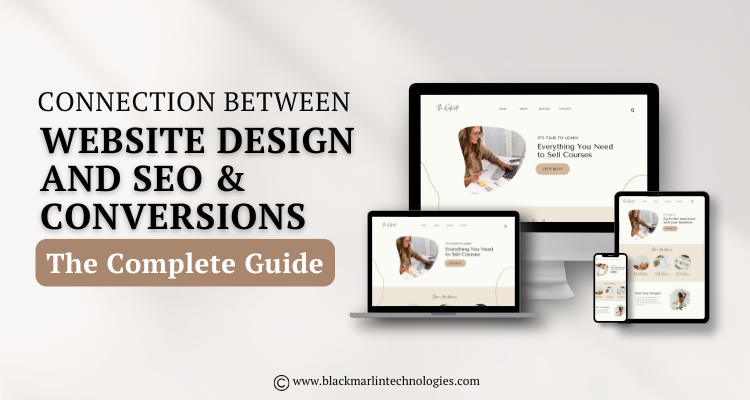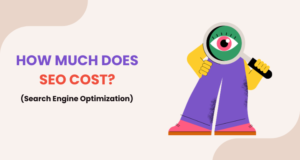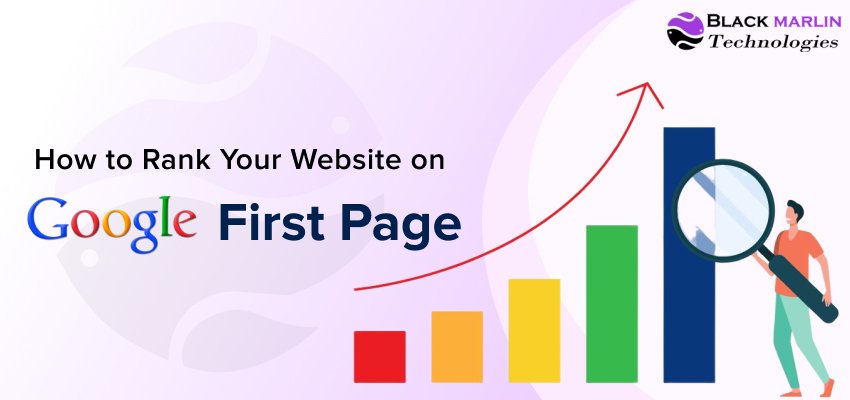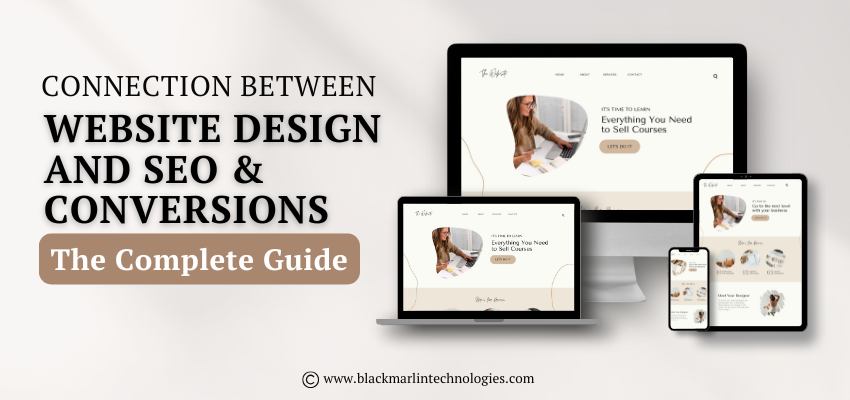
When is the last time you visited a page and were gone in less than a minute? Perhaps the page was just taking a long time to load. Maybe the design seemed as if it had come from the early 2000s. Whatever the explanation, you most likely clucked, “Nope, I don’t trust this site” and hit the back button.
Now flip the script. Pretend you discover a fast modern site, is very clean. The details are readily available. The buttons are clear. You trust the source enough to purchase or sign up. And that’s the magic of good web design.
It’s about more than “looking pretty.” The way your site is designed plays a major role in two critical factors:
- How Google ranks your website (SEO) and
- How effectively you can convert visitors into paying customers (conversions).
Indeed, design can make or break your entire online presence whether in a good or a bad way.
Website Design vs SEO & Conversions
Well, in this foolproof guide, we will take a close look at the impact of website design on both SEO and conversions and most importantly if you can use design to grow your business.
The Importance Of Web Design, And Why You Should Care
The internet is crowded. Today, there are more than 1.8 billion websites. People have myriad options and thinner patience than ever. That is, your website’s first impression is everything.
- Users Are More Demanding
We are in the era of instant everything: instant coffee, instant messages, and instant success. If your platform is slow, cumbersome, or confusing, users are not going to “wait and see.” They’ll jump to a competitor that respects their time.
- Google Is Watching Too
Google’s aim is simple: deliver the very best results to searchers. But best is no longer merely a matter of possessing the right keywords. It’s really a question of how do you give people the smoothest, most beneficial experience. Layout choices such as speed, mobile-friendliness, and the layout of your site are also indicators that Google uses in deciding page rank.
- Business Success Depends on It
Whether you’re an entrepreneur, the CEO of a small business, a nonprofit director trying to get your logo on a reusable mug or a local legislator on a campaign, this is in your best interest.
For most businesses, the website is no longer just an online brochure. It is the primary sales tool. If your design is turning people off, then it doesn’t matter how amazing your product or service is. Before they ever get a chance to become your customers, you’re going to lose them.
Consider your website your digital storefront. Get it dusty, or confusing, or slow, and people will just walk straight on past. They are more likely to walk in and buy if it is clean, inviting and easy to navigate.
How Website Design Impacts SEO
When people hear SEO, they usually think about keywords and backlinks. But design is a silent star player. Why? Because Google pays attention to how people engage with your site. If design persuades people to spend more time, click more and bounce less, that’s a signal to Google that your site deserves to be ranked higher.
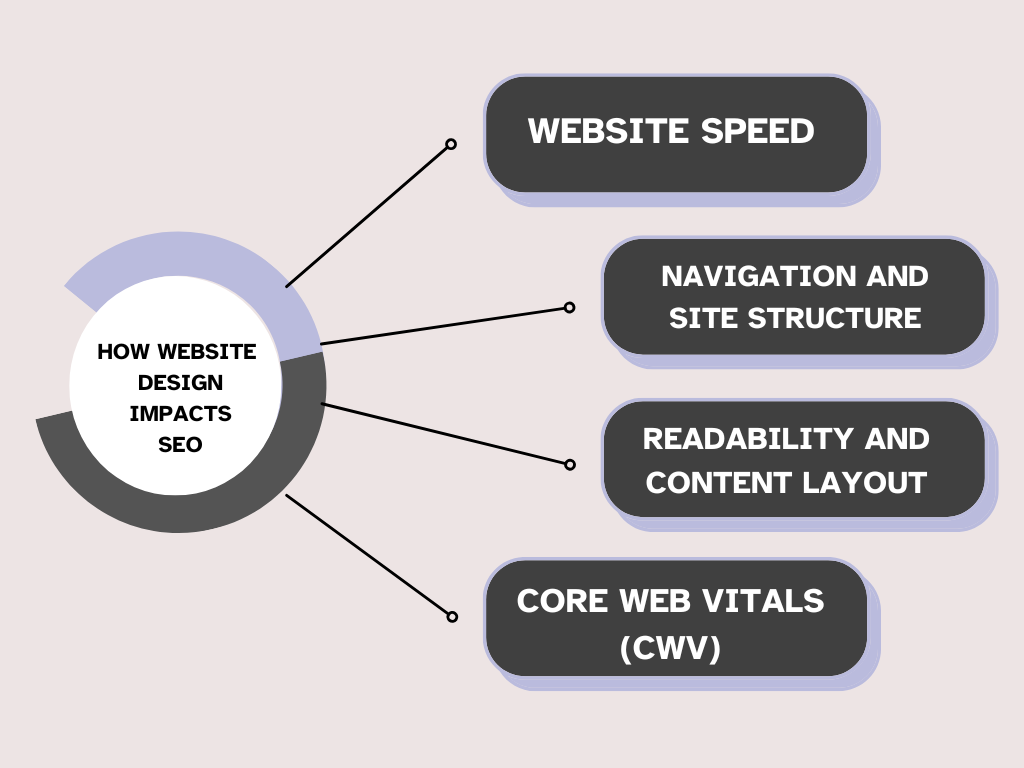
Below are some of the key ways design impacts SEO.
- Website Speed
How much time would you give a site to load? Five seconds? Ten? For most folks, the wait time is three seconds. Google has stated that the speed of your site is a ranking factor.
Except that design is pretty much the enemy of speed. Heavy images, autoplay videos, bloated code, or excessive animations weigh down performance. A clean, speedy design that Google and visitors will love.
- Navigation and Site Structure
Ever visit a website and lost your way? Bad navigation is irritating for humans, but it also leaves search engines scratching their heads. Google bots come to your site by following the links. Your rankings go south if your structure is scuzzy.
Good design results in simple menus, reasonable categories and a clearly discernible path to the next page when trying to move around in the site. Think of it in terms of organizing your home: when everything has a home, people and bots can locate it quickly.
- Readability and Content Layout
SEO isn’t only about what you write; it’s how easy the posts are to read. If your design fills long, gray walls with text, no spacing and no headings, your audience will not engage. And if people don’t click, Google will take notice.
Readable design means:
- Plenty of white space
- Clear fonts and strong contrast
- Short paragraphs and bullet points
- Headings that guide the flow
- Core Web Vitals (CWV)
In recent years, Google launched Core Web Vitals: metrics that gauge how enjoyably a site is to use. They include:
- Largest Contentful Paint (LCP): How quickly the main part of the page loads
- First Input Delay (FID): A good measure of how fast the site is when you click
- Cumulative Layout Shift (CLS): How stable the layout is during loading
Have you ever gone to press a button and it suddenly jumped because something came up? That’s a layout shift, and Google downranks you for it. Good design prevents these headaches.
How Website Design Impacts Conversions
It’s all about being high ranked on Google and to rank well on Google is step one. Step two is getting people to act: buy, subscribe, call or book an appointment. That is where design actually earns its paycheck.
- First Impressions Count
It only takes 0.05 seconds for your website to be judged by people. If the design seems late, busy or sketchy, they’re gone. If it looks contemporary and professional, they stay around.
Consider shopping in the real world. Would you enter a store that was cluttered and poorly lit, with peeling paint? Probably not. Your site operates similarly.
- Clear Call-to-Actions (CTAs)
CTAs serve as the markers that direct users to conversion. That design determines whether they are effective.
- When it is flush, you miss the button
- If the language is ambiguous, people ignore it
- If the color matches, it disappears
Just little things like a “Start Free Trial” button in a bold contrasting button can lift your conversions twofold.
- Visual Hierarchy Matters
People scan, they don’t read word for word. Proper design allows for a flow: headline → subheading → image → CTA. Without structure, users flounder, then leave without acting.
- Trust Signals Build Confidence
Design has the power to create or destroy trust. Things such as (but not limited to) customer reviews, testimonials, certifications, or professional imagery all act like arrows that are pointing in the direction of trust. A generic site creates doubt, and doubt kills conversions.
- Mobile Conversions Are Fragile
Shopping cart abandonment on mobile is close to 70%. Why? As a lot of sites are still designed with desktop in mind. On mobile, little buttons, long forms or cumbersome checkouts annoy people.
Mobile-friendly design that converts for these uses:
- Large, thumb-friendly buttons
- Autofill for forms
- One-page checkout processes
Eight Design Mistakes That Will Ruin Your SEO and Conversions
Everyone makes these common mistakes, even great businesses:
- Cluttered layouts that overwhelm visitors
- Nothing that no one can read (tiny font or low-contrast text)
- Videos automatically playing and slowing everything down and pop-up adverts
- Weak CTAs that are not immediately obvious
- Unbelievably generic stock photos
- Uncompressed images that kill speed
- Confusing navigation: important pages are buried
- Far too many pop-ups that are penalized by Google on mobile
Best Practices: SEO and Conversions Come Together When Designing
Here is the great news: what is good for SEO is also often good for conversions. The two go hand in hand.
- Design Mobile-First
Not “just make it responsive” as some kind of afterthought. Design for mobile first and work your way up to desktop. Try everything on real devices, not just on the browser preview.
- Prioritize Speed
- Utilize image compression (WebP is easily the best)
- Minimize code
- Choose a good host
- Use a CDN
- Keep Navigation Simple
Less is more. Stick to a clear, short menu. Add breadcrumbs for deep pages. Show a search bar at all times.
- Make Content Easy to Read
Write in 16px or larger type size, keep paragraphs short, use bullet points and leave plenty of white space. Incorporate images like charts and pictures for visual variety.
- Establish a Powerful Visual Hierarchy
Lead the eye where you want it to go. Opt for bigger fonts for headers, contrasting colors for CTAs, and natural layouts (F-pattern or Z-pattern).
- Establish Trust On Every Page
Include testimonials, review information, team photos and detailed contact information. Do not hide behind anonymity. Folks want to know who’s behind the brand.
- Test Everything
Don’t pretend to know what works. Run A/B tests on CTAs, colors, and layouts. Heatmaps help you understand what users are clicking. Let the data inform the changes to the design.
Real-World Case Studies
- Case Study 1: E-commerce Brand
One was a fashion store with a slow-loading site and a complicated checkout. Images were compressed, one-page checkout was implemented, and mobile design was simplified, resulting in a 40% increase in conversions and 25% reduction in bounce rates.
- Case Study 2: SaaS Startup
Messy homepage without a specific CTA. After following a clear design path with a clear layout, a single powerful CTA (“Start Free Trial”), and testimonials, sign-ups spiked by 60% in 3 months.
- Case Study 3: Local Operator
An old website for a plumbing company with no reviews or trust elements. A redesign incorporated contemporary visuals, customer reviews and a straightforward “Book an Appointment” button. Leads doubled, and search rankings improved as a result of better engagement.
What Design SEO Will Look Like in the Near Future
The digital planet never stops spinning round. What works one day might not work the next, and early adopters tend to leapfrog far ahead of their competitors. In this post, we’re going to examine some of the trends shaping the current and future of website design, SEO, and conversions.
- AI Personalization
AI is not just science fiction. Thousands of sites are already using AI to make product recommendations, personalize content and adjust layouts in real time. Imagine visiting an online retailer and the homepage automatically reconfigures itself to display items that you are most likely to purchase. Or an SEO SaaS site that promotes features that are industry-specific to you.
It’s not only convenient but the type of personalization increases conversion rates. Research found that personalized experiences can lead to an increase in revenue of up to 10 to 30 percent. For SEO, personalized content increases dwell time and has lower bounce rates, two signals to Google that are attractive.
- Voice Search Optimization
Voice search is taking the world by storm, thanks to smartphones, smart speakers and voice assistants entering people’s homes. Voice search will constitute at least half of all online searches by 2026.
This changes design priorities. Websites will have to be faster to load, have more open designs and conversational content to accommodate voice queries. People are going to ask questions like, “Where’s the best Italian near me?” rather than type in “best Italian restaurant New York.” Which means your design must accommodate structured data, speedy performance, and easily scannable question-and-answer data that is voice-assistant-friendly.
- Minimalism and Clean Design
The era of the flashy, overdesigned website is coming to an end. Minimalism is emerging as the gold standard, not only in aesthetics, but also in performance. Clean templates load faster, are easier to navigate and keep your users’ eyes focused on what matters most: your content and your CTAs.
Minimalist design does not have to be boring. It means clarity. It’s about getting out of your users’ way so they can focus on your value. SEO wise the less unnecessary things you have in there could result in better Core Web Vitals scores and better rankings.
- Accessibility as a Priority
Access is no longer a luxury; it’s a necessity. Millions of people suffer visual, auditory or motor disabilities around the world. A real modern website is a website that everyone can use.
- Accessible design includes:
- High-contrast color schemes for readability
- Alt text for images so screen readers can properly interpret them
- Keyboard-friendly navigation
- ARIA labels for clarity
Accessibility is also good for business, opening you up to new customers and creating trust. From an SEO standpoint, Google loves easy-to-navigate, user–friendly websites. Accessibility will, in the not too distant future, become a matter of course, not a “bonus.”
- Interactive Content
Static pages are fading. Interactivity is in demand, and interactive content fills that want. Further down the funnel, quizzes, product finders, calculators, polls, and interactive infographics can hold someone on your site longer.
For example:
- For a fitness brand, it might be a “Find Your Perfect Workout” quiz
- A real estate company may integrate a mortgage calculator
- A travel site that includes a dynamic map
Key Takeaways
We’re almost there, so let’s tie it all together. Here are the most important lessons any business owner, marketer, or web designer should take away.
- Design Is Key in Shaping SEO More Than You Might Believe – It’s more than just keywords or backlinks when it comes to SEO. Your site’s design affects how Google perceives you. Mobile friendliness, page speed, Core Web Vitals and navigation come from a place of design. If your strategy sucks, adding any amount of keywords won’t matter.
- Conversions Depend on Experience, Not Just Traffic-
Traffic’s only half the battle, however. If your site doesn’t create trust or lead users smoothly then you will fail to convert. The initial response, visual hierarchy, focused CTAs, and trust signals are what make the difference between a visitor leaving or a visitor making a purchase. - Little Mistakes That Are Very Expensive – Crowded layouts, weak CTAs, unoptimized images, and bad mobile design are not things that you can simply dismiss as “small issues.” They are potentially thousands of dollars in lost revenue for you. Each is a design flaw compounding: worse SEO rankings mean fewer visitors, poor UX drives that many visitors away.
- SEO and Conversions Go Hand in Hand – The good news is, the things that help your SEO also help you with conversions. A fast, mobile-optimized, easy-to-use site is the kind of site that both Google wants to reward and that users want to visit. When you think about it, the key to SEO and conversion is pretty simple: don’t make your users think. Instead of slaving away at a bunch of different things to improve your website, you really just need to make your page easy for people to understand and use. It’s another thing you always hear Googlers talking about, and it’s one important CRO tip. Consider SEO and CRO the best of friends on the web.
- The Future Demands Adaptability – Things such as AI personalization, voice search, minimalism, accessibility, and interactive content will define the future. This is a time when businesses that plan now will be set up to win. Those that refuse to change will be left behind.
Final Thoughts
Your site is not just pixels and code. It’s the online face of your business. Good design is something that makes people feel good and inspired and engaged. A bad design sends them packing.
In reality, there are not two distinct objectives: SEO and conversions. They are two sides of one coin, and design is what binds them together.
Businesses that succeed in 2025 and beyond will be those that take design not as decoration, but as a strategy. Invest in a fast, mobile-friendly, secure and easy to use website, and you aren’t just going to gradually climb Google rankings. You will also win more customers.
 +1-(646) 362-1414
+1-(646) 362-1414 +91 8826683820
+91 8826683820

